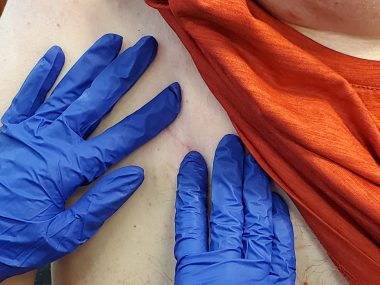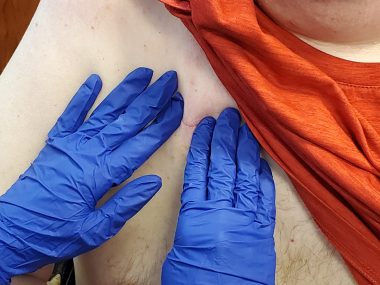Improving Scar Tissue Mobility For My Patient With SMA

As previously mentioned in one of my recent articles entitled “Post-Surgery Care for SMA Patients Taking Physical Therapy,” Michael, my patient with SMA, recently went through an elective surgery to have a subcutaneous port implanted in his chest, to reduce difficulty receiving medications through intravenous lines.
With this surgery, there are two incision sites, one on his neck and one just below his right clavicle. After any surgery, there is a risk of developing scar tissue, which can cause limitations in movement as well as increased discomfort in the area and even surrounding areas due to increased tightness.
For scar tissue mobilization techniques, it is important to wait until the incisions are healed and all scabs are gone from the tissue. Also, make sure the tissue looks healthy and isn’t red, inflamed, or irritated. You can always ensure it is safe by getting clearance from the surgeon if you are unsure.
There are several different mobilization techniques that can be used to increase the mobility of the scar tissue, as well as surrounding tissues. You can apply a small amount of non-scented lotion to the area and begin to work in different directions, such as up and down, side to side, and in circles in a gentle and pain-free motion.


Other techniques that can be used are:
- Tension loading: taking either side of the scar and stabilizing one side while checking tension in different directions of the other side, such as up, down, and moving in opposite directions.
- Compression loading: compressing the scar together and working in different directions with reduced tension on the tissues.
- Rotation: taking either side of the scar tissue and working one side up and the other side down.
- Bending: taking both sides of the scar and working into a downward or upward position.
- Shearing: stabilizing one side of the tissues, such as the top of the scar, and working below the scar in a different direction. For example, if you are bringing the tissues on top of the scar to the right, you would take the tissues on the bottom of the scar to the left.
All these techniques work to increase the mobility of the tissues and reduce scar tissue buildup in the area. These are important techniques that can be used to improve the range of motion of Michael’s neck as he is very limited already. We do not want to allow for scar tissue buildup to continue to reduce his mobility, which reduces his safety awareness if he is not able to scan his environment. With all of this in mind, use the techniques that work best for you and your patient as well as the location of the scar tissue.
============ Patient Perspective ============
Throughout the course of my life, I’ve had numerous surgeries, and certain areas of my body have scar tissue buildup that makes me look like a very crude roadmap. After my surgery to have my subcutaneous port implanted, and while I was at physical therapy the following week, Emily told me that, once I received clearance from my doctor, she would start working to reduce the scar tissue on the wounds on my neck and chest. I looked at her somewhat inquisitively, not knowing that there was a technique that could be used to accomplish this task.
A few weeks later, I received clearance from my doctor, and Emily started working on these scars. The day after my first treatment with Emily, I could already tell a difference. I was feeling a slight tension or pulling of these scars after my surgery, but after going through one treatment with Emily, these scars feel much better, and I no longer feel my skin being pulled or stretched if I twist or turn in certain directions. While this process may take a few more treatments, I feel much better.

